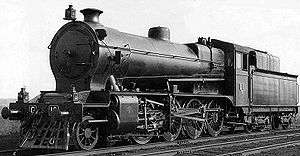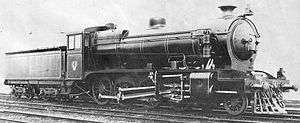Victorian Railways C class
|
VR photograph of C 1, as built in 1918. | |||||||||||||||||||||||||||||||||||||||||||||||
| |||||||||||||||||||||||||||||||||||||||||||||||
| |||||||||||||||||||||||||||||||||||||||||||||||
| |||||||||||||||||||||||||||||||||||||||||||||||
| |||||||||||||||||||||||||||||||||||||||||||||||
The C class was a mainline goods locomotive of the 2-8-0 'Consolidation' type that ran on the Victorian Railways between 1918 and 1962. Although its original design had some key shortcomings, a number of improvements were made over the class' long career on the VR, many of which were subsequently applied to other locomotive classes on the system.
History
Designed by Chief Mechanical Engineer W. M. Shannon,[1] the C class was the first goods locomotive designed and built entirely in-house by the Victorian Railways Newport Workshops, following on from the successful Dd and A2 class passenger locomotives. When class leader C 1 was introduced in 1918, it was the heaviest and most powerful steam locomotive in Australia.[2] It had been necessary for Victorian Railways to strengthen bridges at Dudley Street, North Melbourne and along the lines to Woodend and Seymour on which the new locomotive was expected to run.[3]
Production
The prototype locomotive C 1 was the only one of the class painted in the Victorian Railways 'Canadian Red' scheme. Locomotive C 2 was the first new Victorian Railways locomotive to be finished in the new VR livery of plain, unrelieved black, an cost-efficiency initiative introduced by the new VR Chairman Harold Clapp. It was the first of a further 25 C class members also built at Newport Workshops between 1921 and 1926.
Regular Service
The high tractive effort of the C class locomotives enabled Victorian Railways to operate heavier goods trains with a single locomotive and thus enabled significant savings in operating costs through a reduction in train-miles for the tonnage hauled. Along with the smaller K class branch line 2-8-0, they were credited with playing a major part in the 15% reduction in overall goods and livestock train miles on Victoria Railways between 1920 and 1924, against a reduction of overall tonnage hauled of only 3% for the same years.[4]
Upon introduction, locomotive C 1 was put to work operating through goods trains on the Melbourne to Seymour line. Apart from its ability to operate heavy train unassisted, it was also found to be 5% more efficient in coal consumption per ton-mile than superheater-equipped A2 and Dd class locomotives, and 25% more efficient that A2 or Dd class locomotives with saturated steam boilers.[5]
By 1924 C class locomotives were operating on the Bendigo, North Eastern, and Wonthaggi railway lines, where full trainloads of bulk goods were available. By 1925, they were also operating grain trains from Ararat to Geelong via Maroona where they were able to haul 1200 ton trains unassisted, a 420-ton increase over the hauling capacity of an A2 class locomotive on the same route.[6]
Design improvements
In practice, the C class was initially a somewhat less successful design than the A2. Key shortcomings included a very long, 9 feet 7 inches (2.92 m) manually stoked firebox that was difficult to fire and prone to clinkering, and an undersized boiler.[7] The locomotives tended to run out of steam when worked hard.
In an attempt to rectify these problems, locomotive C 5 was fitted in 1933 with a new front end, based on the Association of American Railroads (AAR) design of self-cleaning smokebox, to improve steaming qualities. The results were very promising and led to further experimental work, using A2 class locomotive A2 998 as a test bed and conducted under the direction of VR Rolling Stock branch engineer Edgar Brownbill, in streamlining the steam passages and other changes to reduce back pressure on the exhaust side and increase efficiency. These changes, referred to as 'Modified Front End', were such an improvement that the rest of the A2 and C classes were progressively modified, as well as all of the K, N, S and X classes.[7][8]
In 1929, C 5 also became the first VR locomotive to be fitted with a cross-compound air compressor, which was also subsequently adopted across other VR locomotive classes.[7] The C class was also the first goods locomotive to be fitted with Automatic Staff Exchange apparatus, given their frequent used on express goods and fruit services.[1]
As the poor quality of coal available after World War II exacerbated the problems of firing the C class and industrial action in the mines threatened supply, the entire class was converted to oil firing from 1946 onwards following an initial conversion of C 15 in 1946. Despite the success of the conversion, C class locomotives were still prone to running out of steam when pushed on long rising gradients.[1]
Whereas other VR locomotives to receive Modified Front End treatment had been equipped with smoke deflectors in the 1930s, it was not until 1947 that the VR finally developed a successful design of smoke deflector for the C class, based on the German "Witte" pattern.[2] This design was then adopted for the final Newport-built N class locomotives as well as the last two steam locomotive classes on the VR, the R and J classes.
Experimental use of pulverised brown coal

In 1923, C 16 was modified with Fuller-Lehigh equipment to run on Pulverised Brown Coal (PBC),[7] a potentially abundant fuel in Victoria given the large brown coal reserves in the Latrobe Valley. Unlike the later conversion of X class locomotive X 32 to PBC firing in 1949, this early experiment was not considered a success and C 16 was returned to black coal operation.[9]
Passenger use
During World War II, increasingly heavy passenger trains and a shortage of suitable motive power saw the C class used as mainline passenger locomotives, a somewhat unusual assignment for a 2-8-0. To facilitate passenger working, their maximum allowable speed was raised from 50 mph (80 km/h) to 60 mph (96 km/h) on the key North Eastern, Ballarat, Bendigo and Geelong lines.[2]
Withdrawal
The postwar rebuilding of Victorian Railways in the late 1940s and early 1950s saw the order of hundreds of new locomotives of superior design to the C class, culminating in the delivery of B class mainline diesel electric and L class mainline electric locomotives.
With these new locomotives entering service, the ageing C class locomotives were progressively withdrawn from service, commencing with C 20 in June 1954. The last C class in service, C 7, was withdrawn in April 1962.[7]
Preservation

C 10 was set aside for preservation on 18 May 1962, after having run 1,160,856 miles (1,868,217 km) during its career on the VR.[2] It is today preserved at the ARHS North Williamstown Railway Museum.
References
- 1 2 3 Oberg, Leon (1975). Locomotives of Australia. Sydney: Reed. p. 127. ISBN 0-589-07173-4.
- 1 2 3 4 Pearce; et al. (1980). North Williamstown Railway Museum. Melbourne: ARHS. p. 12. ISBN 0-85849-018-8.
- ↑ "MODERN ENGINE.". Daily Herald (Adelaide, SA : 1910 - 1924). Adelaide, SA: National Library of Australia. 23 November 1916. p. 4. Retrieved 22 December 2013.
- ↑ "RAILWAYS IMPROVEMENTS.". The Argus (Melbourne, Vic. : 1848 - 1957). Melbourne, Vic.: National Library of Australia. 23 June 1924. p. 13. Retrieved 22 December 2013.
- ↑ "RAILWAYS IMPROVEMENTS.". The Argus (Melbourne, Vic. : 1848 - 1956). Melbourne, Vic.: National Library of Australia. 23 June 1924. p. 13. Retrieved 30 October 2012.
- ↑ "POWERFUL LOCOMOTIVE.". The Horsham Times (Vic. : 1882 - 1954). Vic.: National Library of Australia. 6 January 1925. p. 4. Retrieved 30 October 2012.
- 1 2 3 4 5 "C class steam locomotives". victorianrailways.net. Retrieved 2007-03-31.
- ↑ Abbott, R.L. (November 1971). "Steam Locomotive Performance - the Modified Front End". ARHS "Bulletin". Australian Railway Historical Society (409).
- ↑ Pulverised Brown Coal Fuel for Steam Locomotives Buckland, John L. Australian Railway Historical Society Bulletin, July, 1972 pp145-161
